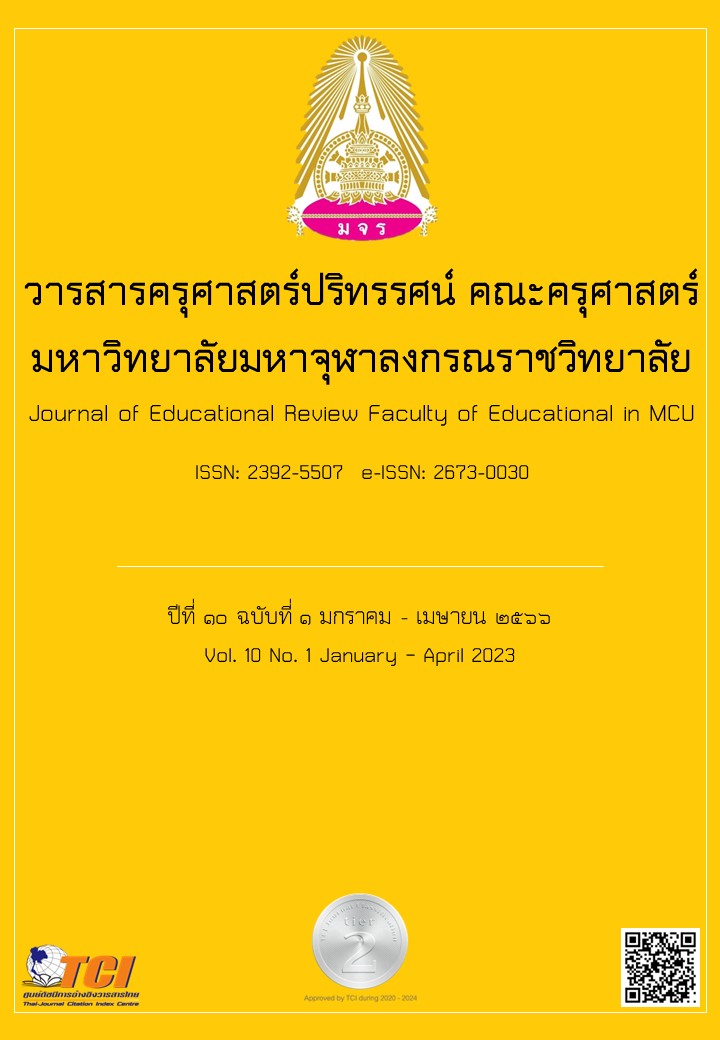A NEEDS ASSESSMENT OF ACADEMIC ADMINISTRATION OF THE SECONDARY SCHOOL UNDER THE SECONDARY EDUCATIONAL SERVICE AREA OFFICE BANGKOK 1 ZONE 2 BASED ON THE CONCEPT OF HEALTH LITERACY
Main Article Content
Abstract
The proposes of this research were to study a need assessment of academic administration of the secondary school under the secondary educational service area office Bangkok 1 zone 2 based on the concept of health literacy. This is a Descriptive Research, and the research tool was a questionnaire. Data were collected from 103 samples including school directors, deputy school director, and teachers. The data were analyzed by using descriptive statistics of, frequency, percentage, means, and priority needs index modified (PNImodified). The research results were as follows: The overall current of state was at the high level and the overall desirable state were at the highest level, respectively. The data was analyzed by PNImodified revealed that the curriculum development of schools was the most needed (PNImodified = 0.367), followed by measurement and evaluation (PNImodified = 0.356), development of educational media and technology (PNImodified = 0.335) and learning process development (PNImodified = 0.330).
Article Details

This work is licensed under a Creative Commons Attribution-NonCommercial-NoDerivatives 4.0 International License.
ทัศนะและความคิดเห็นที่ปรากฏในบทความในวารสารฉบับนี้ถือเป็นความรับผิดชอบของผู้เขียนบทความนั้นเพียงผู้เดียว และไม่ถือเป็นทัศนะและความรับผิดชอบของกองบรรณาธิการ
กองบรรณาธิการขอสงวนสิทธิ์ในการคัดเลือกบทความลงตีพิมพ์และจะแจ้งให้เจ้าของบทความทราบหลังจากผู้ประเมินบทความตรวจอ่านบทความแล้ว
ต้นฉบับที่ได้รับการตีพิมพ์ในวารสารครุศาสตร์ปริทรรศน์ คณะครุศาสตร์ มหาวิทยาลัยมหาจุฬาลงกรณราชวิทยาลัย ถือเป็นกรรมสิทธิ์ของคณะครุศาสตร์ มหาวิทยาลัยมหาจุฬาลงกรณราชวิทยาลัย ห้ามนำข้อความทั้งหมดหรือบางส่วนไปพิมพ์ซ้ำ เว้นเสียแต่ว่าจะได้รับอนุญาตจากมหาวิทยาลัยฯ เป็นลายลักษณ์อักษร
References
กระทรวงศึกษาธิการ. (2551). หลักสูตรแกนกลางการศึกษาขั้นพื้นฐาน พุทธศักราช 2551. กรุงเทพมหานคร: โรงพิมพ์คุรุสภาลาดพร้าว.
กองสุขศึกษา กรมสนับสนุนบริการสุขภาพ. (2553). ผลการสำรวจ Health Literacy ในกลุ่มเยาวชนอายุ 12-15 ปี. นนทบุรี: กองสุขศึกษา กรมสนับสนุนบริการสุขภาพ กระทรวงสาธารณสุข.
ขวัญเมือง แก้วดำเกิง. (2553). การสังเคราะห์องค์ความรู้เรื่องความแตกฉานด้านสุขภาพ. วารสารวิชาการ กรมสนับสนุนบริการสุขภาพ. 23. 46-55.
จิระภา ขำพิสุทธิ์. (2561). ความฉลาดทางสุขภาพ และพฤติกรรมสร้างเสริมสุขภาพของนิสิตมหาวิทยาลัยนเรศวร. วารสารการวัดผลการศึกษา มหาวิทยาลัยมหาสารคาม. 24(1). 67-78.
พระราชบัญญัติการศึกษาแห่งชาติ พ.ศ. 2542. (19 สิงหาคม 2542). ราชกิจจานุเบกษา. เล่ม 116 ตอนที่ 74 ก. 1-23.
รุ่งชัชดาพร เวหะชาติ. (2550). การบริหารงานวิชาการสถานศึกษาขั้นพื้นฐาน. สงขลา: ศูนย์หนังสือมหาวิทยาลัยทักษิณ.
โรงเรียนมัธยมศึกษา สังกัดสำนักงานเขตพื้นที่การศึกษามัธยมศึกษา กรุงเทพมหานครเขต 1 กลุ่ม 2. (2564). ข้อมูลสารสนเทศ สพม. กท.1. แหล่งที่มา https://eoffice.sesao1.go.th/info/ สืบค้นเมื่อ 21 ก.พ. 2565.
สำนักงานเขตพื้นที่การศึกษามัธยมศึกษาเขต 1. (2564). แผนพัฒนาการศึกษาขั้นพื้นฐาน (พ.ศ. 2563-2565). แหล่งที่มา https://eoffice.sesao1.go.th/ สืบค้นเมื่อ 20 ส.ค. 2564.
สุวิมล ว่องวาณิช. (2558). การวิจัยประเมินความต้องการจำเป็น. กรุงเทพมหานคร: องค์การค้าของสำนักงานคณะกรรมการส่งเสริมสวัสดิการและสวัสดิภาพครูและบุคลากรทางการศึกษา.
อติพร เกิดเรือง. (2560). การส่งเสริมการเรียนรู้ในศตวรรษที่ 21 เพื่อรองรับสังคมไทยในยุคดิจิทัล. วารสารวิชาการ มหาวิทยาลัยราชภัฏลำปาง. 10(1). 173-183.
อทิติยา อินแก้ว. (2559). การพัฒนาตัวบ่งชี้และมาตรวัดความฉลาดทางสุขภาวะของนักเรียน: การวิจัยแบบผสมวิธี. วารสารวิชาการจุฬาลงกรณ์มหาวิทยาลัย OJED. 10(1). 262-273.
Best, J. W. (1981). Research in education. New Jersey: Prentice Hall.
Government Gazette. (1999). National Education Act 1999. Section 74 Kor. 1-90.
Khammanee, T. et al. (2005). Various alternative teaching styles. 3rd ed. Bangkok: Chulalongkorn University.
Krejcie, and Morgan, D. W. (1970). Determining Sample Size for Research Activities. Educational and Psychological Measurement. 30(3). 607-610.
Ministry of Education. (2002). The Ministry of Education Act 2003 and the Ministerial Regulation on government sectors. Bangkok: Printing House, Shipping Organization.
U.S. Department of Health and Human Services. (2000). Healthy People 2010: Understanding and improving health. Washington, DC: U.S. Government Printing Office.
World Health Organization (WHO). (1998). Health Promotion Glossary. Division of Health Promotion, Education and Communications, Health Education and Health Promotion Unit, World Health Organization. Geneva.


